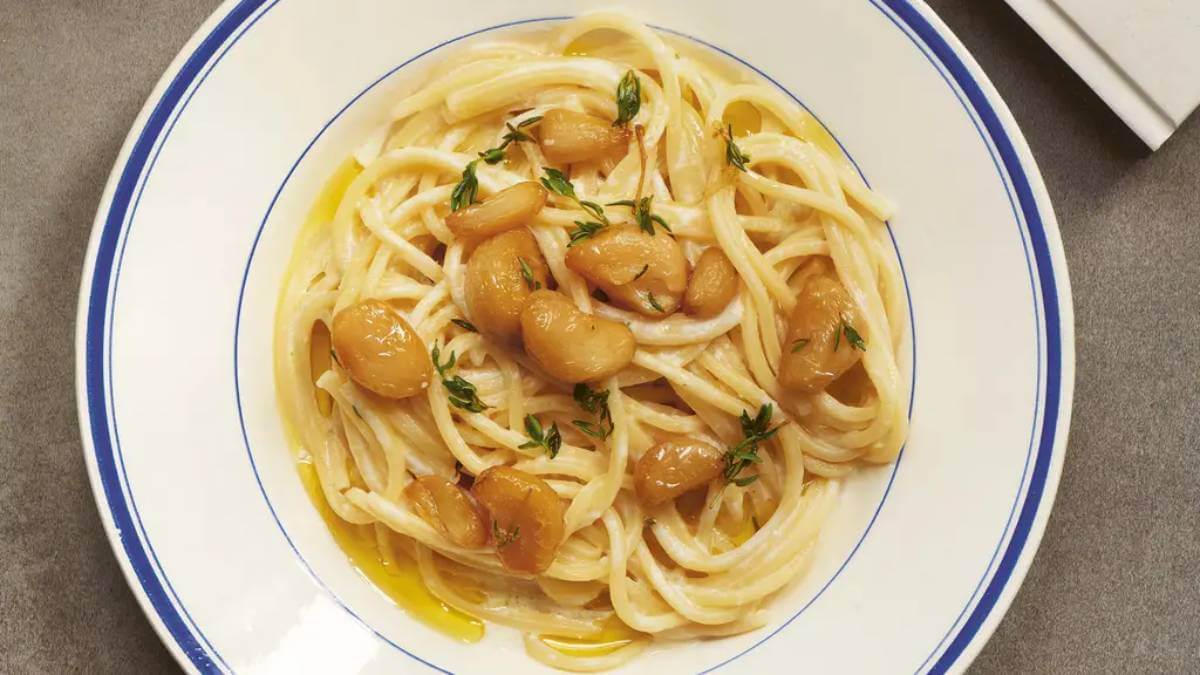“I don’t normally find much pleasure in cooking for just me. Except when it’s this dish,” says Olia Hercules.
“This is adapted from an old Nigel Slater recipe, a writer who inspired me and so many others to look beyond cookbook recipes and to cook more freely and creatively. I turn to this recipe time and again when I have some moments on my own.”
She always serves lettuce leaves on the side, to mop up the pasta sauce with a bit of crunch.
Serves: 2
Ingredients
- 2 small garlic bulbs (yes, that’s correct, 1 per person)
- 100ml good olive oil
- leaves from 4 thyme sprigs
- 200g spaghetti or linguine
- 200g soft goats’ cheese (logs are good)
To serve:
- lettuce leaves
- good vinegar
- sea salt

Method
I haven’t yet found a garlic peeling hack that works. What I do is separate the cloves, then attempt to lightly bash on each with the heel of my hand and cut off the dry root end. The skins then slip off quite easily. If you accidentally squash some (or a lot, like I do, heavy-handedly) of the cloves, don’t worry too much, they can still be used. Put the oil into the smallest saucepan or frying pan you have, heat it gently and spoon in the garlic. The cloves should be submerged in oil and cook very gently over the lowest heat possible.
Read: 10-minute Roast Garlic Broccolini
Sometimes I tilt the pan carefully, helping the cloves to submerge, and stand there holding the pan. But you can always use more oil. It won’t go to waste, as the garlicky oil is so good in other recipes, or to dress boiled vegetables. The garlic will be spluttering away, its water escaping the oil. It has to soften, mellow and colour only ever so slightly. The whole process should take about 20 minutes, but use your judgement. When ready, the garlic will smell very sweet and the cloves can be easily pierced with a knife. Take it off the heat and add the thyme.
Cook the pasta according to the packet instructions. Put the goats’ cheese into a food processor. When there are 3 minutes to go before the pasta is done, ladle 200ml of the pasta water into a measuring jug. Blitz the goats’ cheese with half of the measured pasta water and two to three tablespoons of the garlic oil. You will have a smooth and rather liquid sauce, but do not worry, it will all be good. (If it is not quite liquid, I find the pasta gets too dry.)
Read: Cooking tips to get the perfect pasta every time
Drain the pasta and put it back into the pan in which it was cooking. Pour the sauce over the pasta and, using tongs, move the pasta up and down, making sure to cover the pasta in the sauce. Keep agitating it like this for a minute. At this point I take a mouthful and check if it slips down smoothly. If it feels a bit dry rather than slippery, I add another splash of pasta water and swirl it around with tongs some more.
Put the pasta into serving plates and pour over any goats’ cheese sauce that remained behind in the pan. Serve with the confit garlic cloves scattered over the top and a drizzle of the garlic oil.
When you finish the pasta, pile the lettuce leaves directly into the pasta plate and add a little vinegar and salt. The remainder of the goats’ cheese sauce is so good with the leaves.

Home Food: Recipes To Comfort And Connect by Olia Hercules is published by Bloomsbury Publishing. Photography by Joe Woodhouse. Available now.
What’s your favourite pasta dish? Let us know how the recipe works for you in the comments section below.
– With PA

